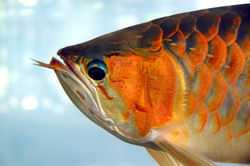Scleropages
| Scleropages | |
|---|---|
 | |
| Super red arowana strain, Scleropages formosus | |
| Scientific classification | |
| Kingdom: | Animalia |
| Phylum: | Chordata |
| Class: | Actinopterygii |
| Order: | Osteoglossiformes |
| Family: | Osteoglossidae |
| Genus: | Scleropages Günther, 1864 |
| Species | |
|
See text | |
Sceleropages is a genus of freshwater fishes found in Asia and Australia.[1] Four species are currently recognized. All are carnivorous and have great jumping ability. Most are endangered in the wild to some degree. Scleropages species are highly valued as aquarium fish, particularly by those from Asian cultures.
Before 2003, three species were recognized from this genus (S. formosus, S. jardinii, and S. leichardti). A fourth species, S. inscriptus, was described from Myanmar in 2012.[2] In 2003, a study redescribed several naturally occurring color varieties of S. formosus, the Asian arowana, into four separate species.[3] The majority of researchers dispute these redescriptions, arguing that the published data are insufficient to justify recognizing more than one Southeast Asian species of Scleropages, and that divergent haplotypes used to distinguish the color strains into isolated species were found within a single color strain, contradicting the findings. They are considered monotypic, consisting of closely related haplotypes based on color.[4][5][6][7][8]
The ancestor of the Australian arowanas, S. jardinii and S. leichardti, diverged from the ancestor of the Asian arowanas about 140 million years ago, during the Early Cretaceous period. The morphological similarity of all six species shows that little evolutionary change has taken place recently for these ancient fish.[9] The genus had a much wider distribution during the early Cenozoic, with fossil remains known from the Paleocene of Niger and Belgium.[10]
Species
The currently recognized species in this genus are:[2][11]
- Scleropages formosus (Sa. Müller & Schlegel, 1844) (Asian arowana, green arowana, Asian bonytongue, Malayan arowana)
- Scleropages inscriptus T. R. Roberts, 2012 (Myanmar arowana)[2]
- Scleropages jardinii (Saville-Kent, 1892) (gulf saratoga, Australian arowana, Australian bonytongue, northern barramundi)
- Scleropages leichardti Günther, 1864 (saratoga, Australian arowana, Dawson River salmon, spotted saratoga, spotted barramundi, spotted arowana)
Three additional taxa are disputed:
- Scleropages aureus Pouyaud, Sudarto & Teugels, 2003 (gold arowana, red-tailed golden arowana)
- Scleropages legendrei Pouyaud, Sudarto & Teugels, 2003 (red arowana, super red arowana, blood red arowana, chili arowana)
- Scleropages macrocephalus Pouyaud, Sudarto & Teugels, 2003 (silver Asian arowana, yellow-tailed silver arowana, gray-tailed silver arowana)
References
- ↑ Froese, Rainer, and Daniel Pauly, eds. (2011). Species of Scleropages in FishBase. June 2011 version.
- ↑ 2.0 2.1 2.2 Tyson R. Roberts (2012). "Scleropages inscriptus, a new fish species from the Tananthayi or Tenasserim River basin, Malay Peninsula of Myanmar (Osteoglossidae: Osteoglossiformes)". Aqua 18 (2): 113–118.
- ↑ Pouyaud, Laurent; Sudarto & Guy Teugels (December 2003). "The Different Colour Varieties of the Asian Arowana Scleropages formosus (Osteoglossidae) are distinct species: Morphologic and genetic evidences". Cybium 27 (4): 287–305.
- ↑ Yue, Genhua; Li, Yang; Chen, Fan; Cho, Serena; Lim, Lian Chuan; Orban, Laszlo (2002). "Comparison of three DNA marker systems for assessing genetic diversity in Asian arowana (Scleropages formosus)". Electrophoresis 23 (7-8): 1025–1032. doi:10.1002/1522-2683(200204)23:7/8<1025::AID-ELPS1025>3.0.CO;2-Y.
- ↑ Hua Yue, Gen; Li, Yang; Lim, Lian Chuan; Orban, Laszlo (2004). "Monitoring the genetic diversity of three Asian arowana (Scleropages formosus) captive stocks using AFLP and microsatellites". Aquaculture 237 (1-4): 89–102. doi:10.1016/j.aquaculture.2004.04.003.
- ↑ Kottelat, M.; E. Widjanarti (2005). "The fishes of Danau Sentarum National Park and the Kapuas Lakes Area, Kalimantan Barat, Indonesia". The Raffles Bulletin of Zoology: 139–173.
- ↑ Mohd-Shamsudin, Maizatul Izzah; Fard, Maryam Zahedi; Mather, Peter B.; Suleiman, Zaini; Hassan, Rosly; Othman, Rofina Yasmin; Bhassu, Subha (2011). "Molecular characterization of relatedness among colour variants of Asian Arowana (Scleropages formosus)". Gene 490 (1-2): 47–53. doi:10.1016/j.gene.2011.08.025.
- ↑ Mu, Xi-dong; Hong-mei Song, Xue-jie Wang, Ye-xin Yang, Du Luo, Gand-en Gu, Jian-ren Luo, Yin-chang Hu (2012). "Genetic variability of the Asian arowana, Scleropages formosus, based on mitochondrial DNA genes". Biochemical Systematics and Ecology 44: 141–148. doi:10.1016/j.bse.2012.04.017accessdate=22 April 2013.
- ↑ Kumazawa, Yoshinori (2003). "The reason the freshwater fish arowana live across the sea". Quarterly Journal Biohistory (Winter). Retrieved 2006-07-02.
- ↑ Taverne, Louis (2009). "On the presence of the osteoglossid genus Scleropages in the Paleocene of Niger, Africa (Teleostei, Osteoglossomorpha)". Bulletin De L’institute Royal des Sciences Naturelles de Belgique (79). Retrieved 2013-09-04.
- ↑ Froese, Rainer, and Daniel Pauly, eds. (2012). Species of Scleropages in FishBase. February 2012 version.